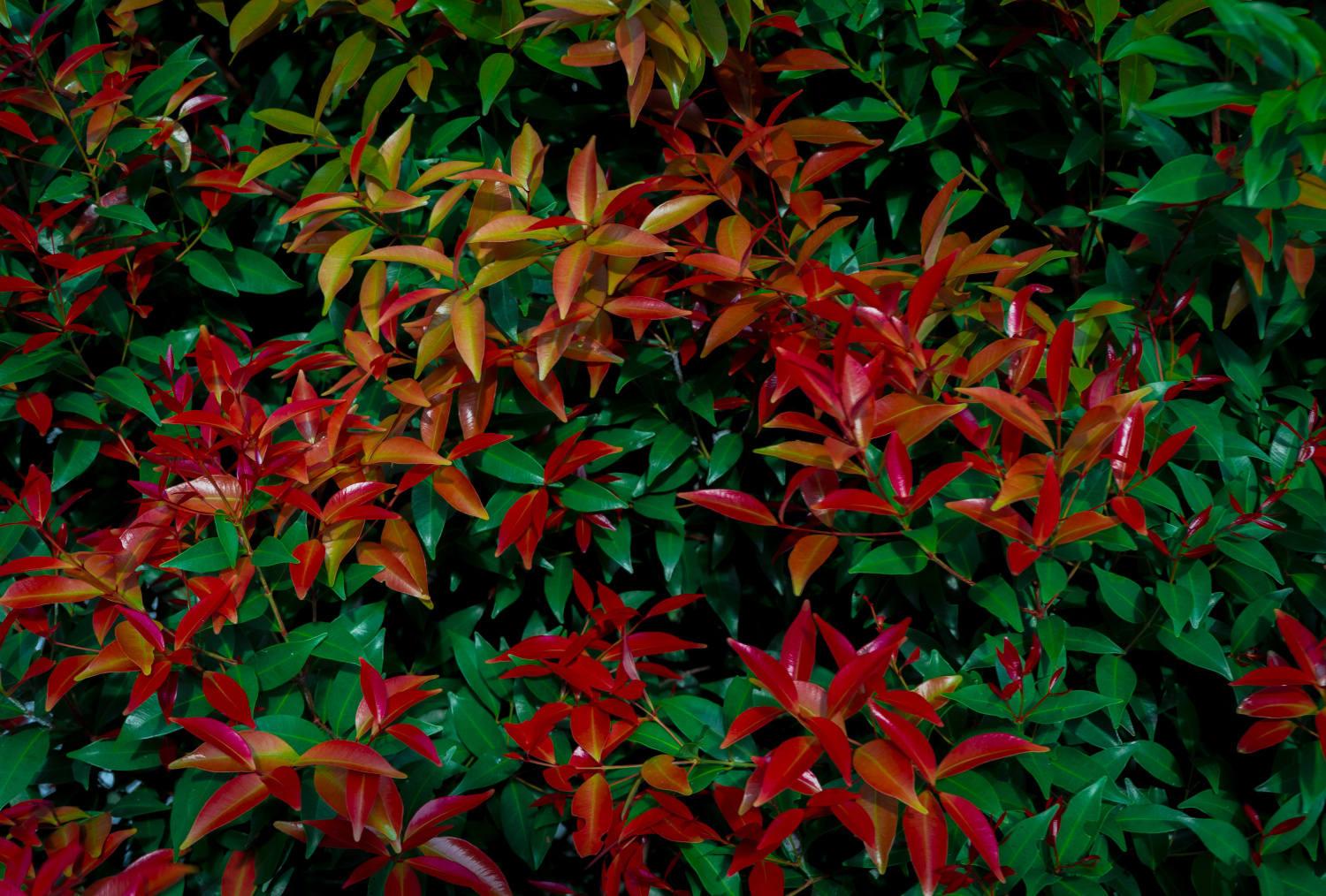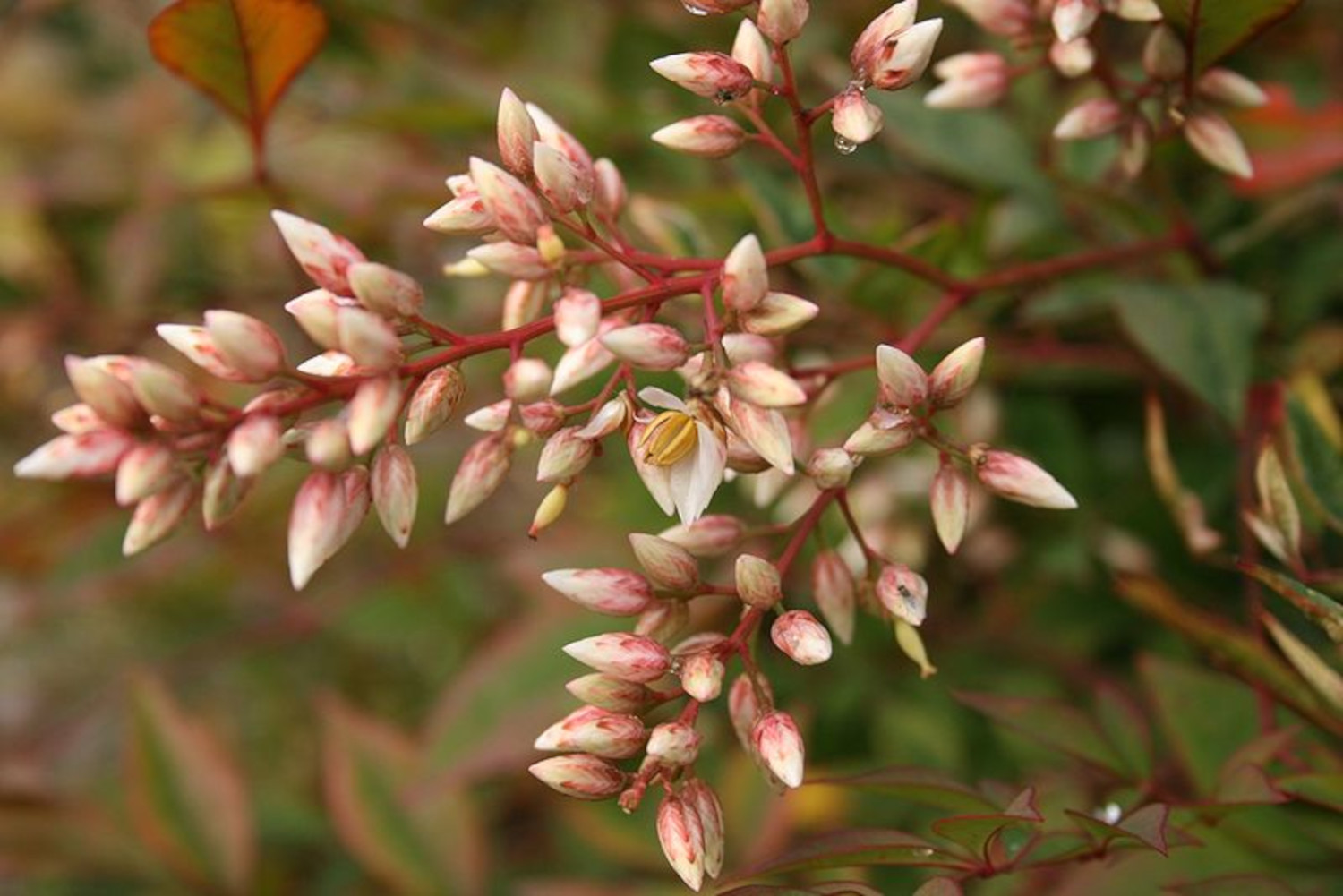Focus on: Nandina Domestica
The favourite plant of professional plantsmen, Nandina domestica has a place in any landscape.
Why Nandina domestica?
Heavenly bamboo, sacred bamboo or Chinese sacred bamboo, Nandina domestica, is an elegant evergreen or semi-evergreen shrub that looks good in every season. Its delicate, evergreen foliage has red or purple tints in spring and in summer, the plant bears sprays of tiny white flowers. In summer, the foliage turns pale green, and green berries begin to appear. These turn bright red in autumn, as the foliage takes on fiery red or bronze tints. The berries and foliage remain on the plant throughout winter, giving colour and interest. Birds love the berries.
Despite its name, heavenly bamboo isn’t actually isn’t a bamboo at all. It looks similar, but it is actually a member of the Berberis family, Berberidaceae. It is, however, a good alternative to bamboo in the garden – not only does it provide more interest but it is not invasive, as some bamboos can be.
Nandinas are compact shrubs, perfect for smaller gardens and pots. Larger varieties reach 2m, and smaller varieties less than one metre. They are low maintenance, needing just a light trim in spring. Nandina domestica looks particularly good in an urban or contemporary garden or in a jungle-style planting scheme. There are different cultivars to choose from that offer a variety of leaf colours.

The vivid autumn colour of Nandina domestica ‘Fire power’.

The attractive blushing blooms of Nandina domestica. – Sten, CC BY-SA 3.0 <https://creativecommons.org/licenses/by-sa/3.0>, via Wikimedia Commons
How to grow Nandina domestica
Nandina domestica is low maintenance and easy to grow. Plant in spring or autumn, in a sunny, well drained spot that is sheltered from cold, drying winds. Nandinas do best in a slightly acidic soil, so mulch with bark chippings after planting. Nandina doesn’t need pruning but can be lightly trimmed and tidied up in spring.
The best time to plant nandina depends on whether you’re planting seeds or cuttings. Seeds should generally be planted into soil in late spring, whilst cuttings should be taken as semi-hardwood in early autumn, and planted immediately into cuttings compost.
Upon planting, you should always water your nandina domestica well, and make sure to keep soil moist but well-drained during the initial growing period.
Habitat & Growing Conditions
Nandina domestica’s natural habitat is mostly the mountain forests of eastern Asia, including the Himalayas, central China and Japan. The plant prefers a sunny, sheltered climate for growing, with a rich, moist soil.
In Japan, heavenly bamboo is often grown in pots near doorways, so that when you wake from a nightmare, you can tell the plant about your dream. It is said that the plant will then dispel it, preventing it from hurting you.
How do you care for Nandina?
Nandina domestica is hardy in the UK climate and can tolerate temperatures between -23°C to 43°C. It can therefore be left outside year-round, and does not generally need to be protected from frost over winter, unless in a particularly cold or exposed position.
Although it can tolerate low temperatures and partial shade, nandina domestica much prefers full sun, and so you should try to choose an east, west or south-facing location in your garden, if possible. The plant prefers a sheltered spot, away from any cold, drying winds.
Heavenly bamboo will grow in almost all soil types and pHs, including sand and clay – although it does not really like chalk. It prefers its soil to be rich and moist, but, as with most plants, does not like to be waterlogged, so make sure it has sufficient drainage.
Nandina domestica makes an ideal border plant, and many dwarf varieties are also well-suited to container growth. Once established, heavenly bamboo is a low maintenance plant, and requires very little ongoing care. It should not require feeding, fertilising or watering, except in periods of drought.

Nandina berries are also aesthetically pleasing, making the shrub one of the best all-rounders. – Picture : Emmanuel Douzery
How do you prune Nandina?
You can prune most evergreen shrubs just before growth starts in mid-spring, after any risk of frost has passed. Pruning at this time will avoid frost damage to new shoots, and any pruning scars will be concealed by new growth.
As mentioned above, established nandina domestica requires little ongoing care – and this includes pruning. Pruning is only really necessary to remove dead wood, or diseased shoots. You may also wish to prune to reshape your plant, to encourage new growth for propagation, or to remove an unwanted plant that has spread underground. Prune lightly, removing unsightly shoots as required.
The best time to prune nandina domestica is in mid to late spring, prior to new growth, but after the last risk of frost has passed. Aim to remove any obviously dead, damaged or unsightly shoots. If required, you can also thin the plant out, to improve its appearance. After pruning, water, mulch and feed your plant, to encourage new growth.
Evergreens that are still flowering or about to flower in mid-spring can be left until flowering has finished. When pruning any evergreen shrub (except old, overgrown shrubs, see below), aim to remove about one-third of older wood in total. Prune out any diseased, damaged or dead shoots using long-handled loppers or a saw if necessary. And finally, thin out crowded shoots and any badly positioned ones that spoil the shrub’s appearance
After pruning, plants benefit from mulching and feeding. Use either a general-purpose fertiliser or specialist rose or other high-potassium fertiliser.

